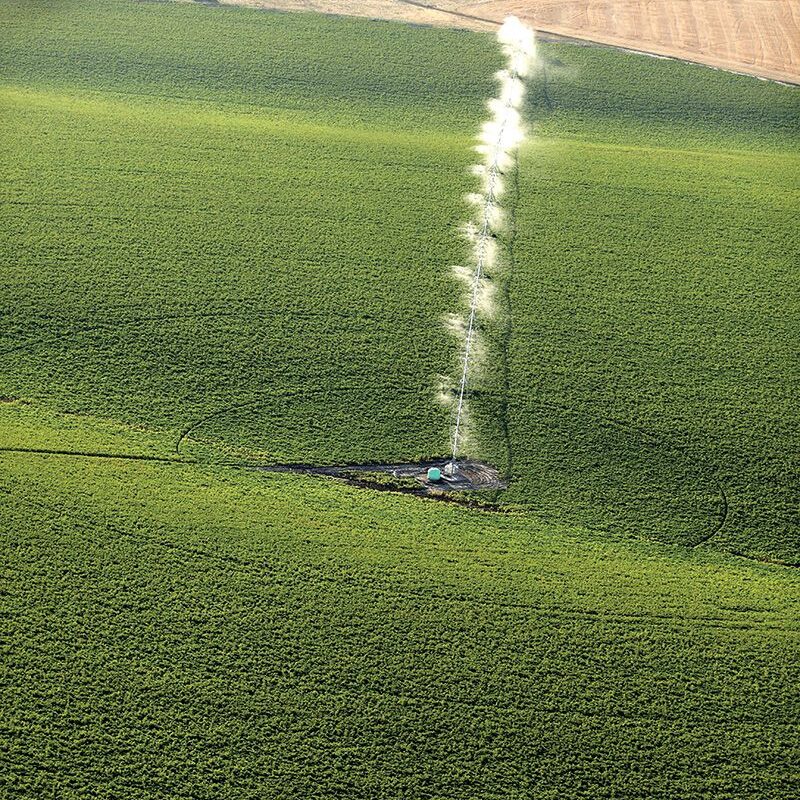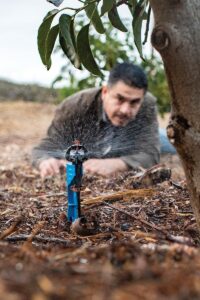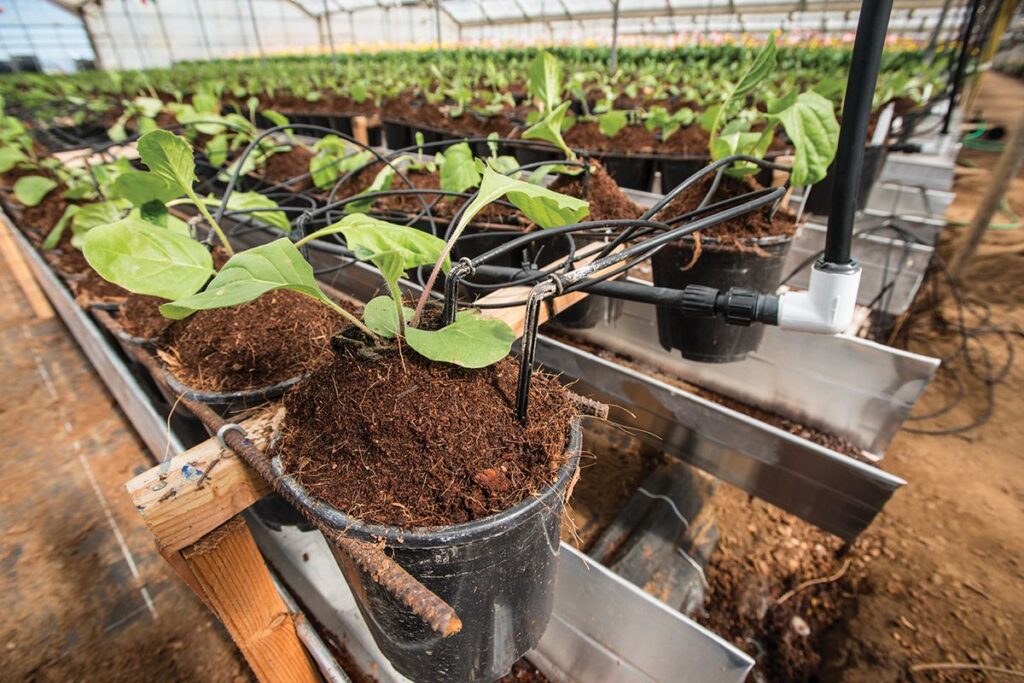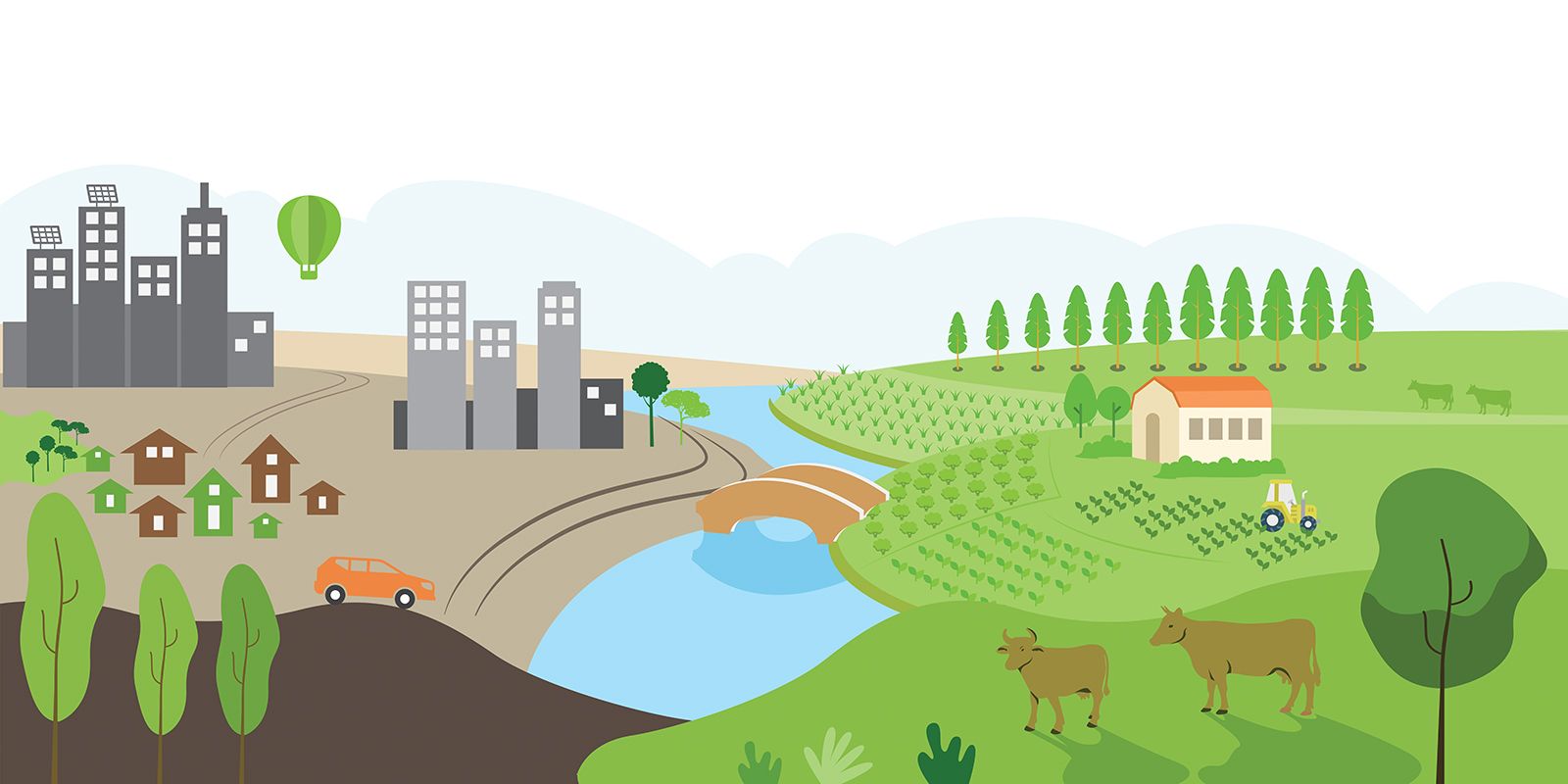This special issue of PERC Reports explores the West’s water crisis and how markets can address today’s shortages. Read the full issue.
Alfalfa often gets an unfair rap. As a legume, its deep root system and ability to fix nitrogen improves soil. It provides essential forage for dairy cows and other livestock. Yet it is often criticized for being one of the thirstiest crops western farmers can grow. And from Wyoming to California, farmers in the Colorado River Basin grow lots of it—several million acres each year—even as the region struggles to adapt to a historic drought affecting the river that supplies water to 40 million people.
Imagine if a farmer in the drought-stricken basin could profit by cutting back on alfalfa production and leasing the saved water to a far-off city. He might generate the water savings by skipping a third cutting of hay, making do with income from the first two and the water lease. Or he might take a parcel of marginal farmland out of production entirely and then use the new water revenue to invest in boosting yields on the rest of the farm.
The water would not be physically moved anywhere. The farmer would simply leave it in the river to be taken out by a municipality downstream. An urban area in need of water would benefit, and the farmer would have a new source of revenue, plus the flexibility to decide whether or how to alter agricultural operations to get by with less irrigation. Or perhaps a conservation group pays the farmer for the water and chooses to leave it instream to further environmental aims, such as bolstering fish habitat.
This seemingly simple idea—that someone who needs water should be able to pay another user to voluntarily forgo water use—turns out to be exceedingly difficult in many cases.
With about 80 percent of western water used in agriculture, momentum is building to find ways to do just that—buy or lease water from farmers to help address the region’s severe drought conditions. But in reality, the challenge of putting water to use where it’s most valued is complicated. Throughout much of the West, this hypothetical trade with an alfalfa farmer is difficult if not impossible due to a lack of well-functioning water markets and barriers to water leasing.
If more basin users could trade with each other, water could be directed to places most in need of it. But this seemingly simple idea—that someone who needs water should be able to pay another user to voluntarily forgo water use—turns out to be exceedingly difficult in many cases.
Simple Idea, Complex Reality
In theory, it should be straightforward for one basin user to trade or lease their water rights to another. But as PERC’s Bruce Yandle recently wrote in The Hill, throughout the American West “there is no institutional arrangement enabling any state or large water-using entity to trade with another. No regional market where water rights are priced or otherwise valued in a way that fully leverages economic incentives to balance demand with diminishing supply and pays for creative ways to conserve.”
Alfalfa farmers in Wyoming or Utah, for example, cannot cut back on irrigation and lease their saved water to Las Vegas or Phoenix. That lack of a framework for trading water across state lines—efficient markets that match sellers with buyers willing to trade an increasingly valuable resource—is one reason for current shortages. It’s especially relevant in the Colorado River Basin, which encompasses a quarter of a million square miles across seven states, more than two dozen tribal nations, and Mexico.

Even within a single state, several barriers impede water trades. Water rights are often bundled to a particular parcel of land, and it can be difficult to transfer those rights to another party. Water that is not put to “beneficial use” could be forfeited, and in some cases water that is conserved may be claimed by other users; this punishes rather than rewards people for conserving water and encourages overuse.
The reality is that the allocation of water among states in the Colorado River Basin has always been based on political, not economic, considerations. But with severe drought facing the West, it’s clear that something’s got to give. People in the region will have to use less water in coming years, and much of the savings will likely come from the agricultural sector given how much it uses. How those reductions will happen—whether through mandated cutbacks, regulations, or voluntary conservation efforts—is the big question.
Paying to Cut Back
“Honestly, I think I could make more money farming,” Brad Robinson, a third-generation farmer in Blythe, California, recently told the Los Angeles Times. “But for the sake of the Colorado River, I think it’s the right thing to do.” Robinson and other farmers in the Palo Verde Irrigation District participate in a program that pays farmers to temporarily fallow fields—in other words, to not farm. The water the farmers would use to irrigate alfalfa, cotton, and other crops instead stays in Lake Mead, the largest reservoir in the Colorado River Basin. The program is funded by a combination of federal, state, and local entities. “In a perfect world,” Robinson said, “a farmer wants to farm. But the reality of the situation is that we have a certain amount of population and people, and don’t have unlimited water.”
Due to barriers that keep people from purchasing or leasing water directly from farmers, many have looked for alternative ways to reward farmers who reduce water use and free up flows for other users or conservation purposes. These include governments compensating farmers to cut back on irrigation, municipalities paying farmers to fallow fields, and conservation groups seeking reforms that allow instream flow rights for fish and wildlife habitat.
Two factors help such efforts overcome obstacles that hinder direct water trades. First, deals that do not involve a formal exchange of water rights avoid the various legal and policy barriers to trading water. Second, such efforts are usually carried out on a local scale and within a single state. That proximity reduces jurisdictional complexity and increases assurances that a third party cannot divert the saved water for their own purposes. The water conserved by Palo Verde farmers in Lake Mead, for example, can be drawn from the reservoir by nearby cities. The Metropolitan Water District of Southern California, which supplies 19 million people across Los Angeles, San Diego, and other municipalities, has paid farmers in the Palo Verde Valley a total of $180 million since 2005 to fallow farmland.

Efforts to pay farmers to cut back are ramping up in light of today’s shortages in the Colorado River Basin. In September, the Bureau of Reclamation announced a major new effort to pay for water conservation. The agency will pay farmers in lower basin states—Arizona, California, and Nevada—to voluntarily cut water use. One part of the program will offer $330 to $400 per acre-foot forgone, and the unused water will remain in Lake Mead. While the payments may end up providing some relief, many questions remain. How will the agency decide which farmers to pay? Will the prices offered be enough to produce the necessary water savings?
PERC’s Bryan Leonard and Montana State University economist Nick Hagerty recently outlined one way to address those issues: use a reverse auction. “In most auctions, people bid what they are willing to pay to acquire something,” they wrote in October for High Country News. “Here, water users would bid what they are willing to accept in order to forgo a certain quantity of water deliveries. The government would then accept the lowest bids.” They noted that a reverse auction would get more conservation “bang for its buck” than Reclamation’s proposed fixed-price contracts. Using rough estimates, they calculate that the approach could generate enough water savings to satisfy all needed reductions in the lower basin for two to seven years with the program’s $4 billion budget.
A key benefit of a reverse auction is that it would help direct water cuts to where they are most economically feasible and rational—for example, toward lower-margin crops such as alfalfa instead of higher-margin ones. Water could remain in agricultural areas where it is most valuable.
One of those areas is Yuma, Arizona. Nestled along the Colorado River in the southwestern corner of the state, Yuma is home to a relatively high-value agricultural sector. During the winter, roughly three-quarters of store-bought leafy greens from coast to coast come from the area surrounding the city. It’s unlikely that farmers there will be attracted to the government payments, and it’s not hard to understand why. Yuma farmers have already signaled that it would take $1,500 per acre-foot for them to consider cutting water use—far more than what the Bureau of Reclamation is offering. Growers in Imperial Valley, California, who also farm a great deal of vegetables and fruits and have the most senior water rights in the lower basin, have floated a figure of $2,300 per acre-foot.
This illustrates one of the key benefits of Leonard and Hagerty’s reverse-auction approach: If an acre-foot of water produces significant revenue from vegetables grown during the Southwest winter, then a farmer will demand a high price to stop irrigating with that acre-foot. The opportunity cost of irrigating, say, an alfalfa field in the basin, however, is likely much lower. Consequently, lower-value producers should have lower asking prices for their water.
Don’t Sell the Farm?
Whether through a fallowing program or another type of agreement, there are various environmental and economic concerns over any efforts to move water from agricultural to urban uses. Leonard recognizes that a reverse auction wouldn’t be perfect. “One big concern,” he said, “is that there are a lot of real externalities from agricultural water use that wouldn’t get priced into bids.” Some of those issues relate to what happens to return flows—when a field is irrigated, where does the water that drains away end up? In California, water that drains off of irrigated fields helps control dust pollution from the Salton Sea and feeds wetlands elsewhere. “If I’m a farmer making my bid,” said Leonard, “I wouldn’t necessarily take those issues into account.”

There are other concerns as well, such as how paying farmers for surface water affects groundwater pumping. PERC’s Sheila Olmstead, an economist at the University of Texas’s School of Public Affairs, has explored the interaction between surface water and groundwater, noting that the latter is “a connected resource that is regulated differently all over the West.” In many states, groundwater is a common-pool resource, and anyone who can drill and access the aquifers lying below their land can pump and use as much as they please.
“In a variety of contexts,” Olmstead said, “research shows that markets and trade can accelerate depletion of natural resources when the local price isn’t driving demand, but the state or even regional price is.” She noted that a program like Reclamation’s could have a similar effect: “You definitely could have a situation where the federal incentive payments could make things worse where groundwater is poorly regulated.” If farmers are free to pump more groundwater after getting paid to reduce their surface water use, then the consequence may simply be that aquifers, rather than above-ground reservoirs, get depleted.
Another major concern of moving water to cities comes from agricultural communities who rightly worry about the consequences for their ways of life. PERC’s Gary Libecap recently described how the media often portrays this dynamic: “Private buyers strip a region of its water, leave it ‘high and dry,’ ship the water elsewhere, and get rich. Local economies and the natural environment are devastated.” Indeed, these potential community impacts are a major source of opposition to large-scale ag-to-urban water transfers.
Compensating farmers for conservation at least provides flexibility. A water lease or fallowing program, for instance, could be short term or much longer in duration. Revenue from a few years of leasing or participating might fund transformation of irrigation infrastructure, measurement, and efficiency—or help a farmer switch to less water-intensive crops. The options offered along all of these margins could be what helps keep a farm farming. And whether a farm keeps farming has repercussions beyond its property lines.
Any future that involves moving water from agricultural to urban uses will have to address concerns of farming communities. Markets at least offer flexibility, and in principle they can be designed to ensure people in rural areas aren’t left behind even if water flows elsewhere.
Many industries that surround and support agriculture exist based on economies of scale—packaging houses, processing plants, suppliers, distributors, and seasonal farm laborers themselves. If there’s a threshold needed for a mill or processor to be viable in an area, for example, then it’s only logical that farmers worry about moving water to cities. And if rural economic changes risk population leaving, property values decreasing, and tax revenues falling, then it would be a wonder if locals were not wary of water transfers.
“One solution,” Libecap recently wrote in a report on water markets published by PERC, “is to broaden the benefits of water transactions via local mitigation funds. The evidence suggests that there are sufficient gains from moving water from low- to high-valued uses to support such efforts.” He pointed to an estimated 18-fold difference in the value of water on Colorado’s West Slope, largely agricultural, and its East Slope, home to Denver and other urban areas. “There clearly are enough monetary gains to contribute to a mitigation fund,” he noted, suggesting a county-level tax on water transfers, similar to severance taxes on oil and gas extraction, could be a vehicle to implement such a policy.

When it comes to the Colorado River Basin specifically, Libecap highlighted the inability to transfer water rights across state boundaries as an enormous challenge. He acknowledged that changing the multistate compact that governs the river “would seem like a very slow, cumbersome process,” likening it to rewriting a state constitution. “But some structure to allow for water to flow instream to meet some of the compact’s requirements would make sense,” he said. “It ought to be the case that there’s some marginal water used in Imperial Irrigation District,” he continued, “or for that matter Palo Verde, that would be more valuable if used in Arizona, or Las Vegas, or someplace else, and the water could be transferred. You wouldn’t need infrastructure to move the water itself, you’d just withdraw less downstream and take more upstream.”
Any future that involves moving water from agricultural to urban uses will have to address concerns of farming communities. Markets at least offer flexibility, and in principle they can be designed to ensure people in rural areas aren’t left behind even if water flows elsewhere.
Trading Off
While western states may have systems of water rights, significant challenges and uncertainties remain embedded within them. The upshot is that they lack a foundation of transferable rights that would be needed to promote widespread, mutually beneficial trades to allocate scarce water throughout the basin.
Markets have the capacity to spread information, harmonize activity, and make trade-offs in ways that few other tools can.
Still, there are several ways to spur institutional innovation for the future. For one thing, policymakers could establish clear property rights to groundwater pumping to make sure that users can’t simply substitute unsustainable aquifer use for surface water use. They could also help usher in better measurement and data gathering when it comes to water use—a huge issue for countless irrigators—and maybe even build in funding to help farmers implement ways to measure use. And as Leonard and Hagerty point out, they could adopt reverse auctions and other tools that harness market mechanisms to ensure that conservation efforts are as efficient and effective as possible.
Ultimately, as shortages get worse, the payoff to innovation will increase, including for reforms that allow water markets to thrive. Solving the West’s water crisis will require coordination across states encompassing dozens of watersheds and tens of millions of people. Markets have the capacity to spread information, harmonize activity, and make trade-offs in ways that few other tools can. Pioneering new ways to harness their power will unleash the type of bottom-up conservation that can help the basin adapt to its drier reality.




